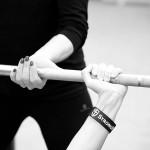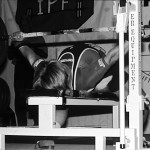When I teach the bench press during the StrongFirst Lifter Certification, the path of the bar section is one of my favorites. In the deadlift and the squats (Zercher, front, and back), the bar path is generally a straight, vertical line. However, in the bench press, many people curve the bar path from the start position above their collar bone, down to their chest, and then curve it again going back up to the start position. I don’t know about you, but that seems like a long and unnecessary way to travel with the bar.
In high school geometry I learned that the shortest distance between two points is a straight line. When you see someone who has not been taught proper bench press technique, the distance the bar travels is long, inefficient, and unnecessarily taxing. A suboptimal bar path means the barbell is traveling a longer distance which results in more work for the student bench pressing any given weight. This leads the student to fatigue earlier than one who is pressing a lesser distance.
There are a few ways to optimize your bench press bar path. These will allow you to not only increase the weight on the bar lifted, but also decrease potential injuries.
Three Ways to a Better Bar Path in the Bench Press
- Increase your thoracic extension.
- Keep your upper arm 45 degrees to your rib cage during both the descent and ascent.
- Touch the bar on your chest between your nipple line and your xiphoid process.
Increase your thoracic extension.
In the Foundations section of the SFL we discuss the importance of making sure that your thoracic spine extension is adequate. Unfortunately, in today’s society, the constant use of computers, cell phones, and tablets causes us to round our shoulders, flex our necks, and increase the rounding (flexion) of our thoracic spine. This doesn’t bode well for us strength lovers as it is contrary to what we need to do when lifting. To improve this thoracic extension we use the foam roller and the kettlebell arm bar. During the bench press section specifically, we introduce the use of the yoga block and the kettlebell pullover as additional tools to aid in restoring and increasing your thoracic extension. You can use these mobility drills as a specific warm-up for any upper body exercise and also to increase extension while loosening your thoracic spine’s tension and propensity for hyperflexion.
Keep your upper arm 45 degrees to your rib cage during both the descent and ascent.
This is an important step during the actual moving of the bar downward and upward. Most people can keep the 45-degree angle on the way down, but have a difficult time on the way up, typically flaring the elbows out. This flaring out of the elbows generally causes the upward curve of the barbell back towards the face. This also causes undue stress on the acromioclavicular (AC) joint as the elbow flares out and can lead to injury.
Making sure that you set your scapula before lifting the bar out of the rack is also important. Depressing and retracting the scapula strongly is important here as it also protects the AC joint and the shoulder joint. I always tell SFL students to place their scapula in the opposite back pocket.
Practicing keeping your humeral angle at around a 45-degree angle not only takes strength in your lats, but it also takes decisive intention to do so. The speed of the bar down and up must be slow at first as you learn this new pattern. Once you have engrained the new motor pattern (after 1,000 reps or approximately a year) you can increase your upward speed.
Touch the bar on your chest between your nipple line and your xiphoid process.
Usually the first question I get at this point is, “What is the xiphoid process?” The xiphoid process is the lowest of three bones that make up the sternum and is located at the juncture of your bottom ribs. This area, between the nipple line and your xiphoid process, is what I call the “golden area.” It is so named because when someone touches the bar to their chest in this area, almost everything regarding the first two items above are taken care of: the student has adequate thoracic extension and a good humeral angle. Conversely, touching higher on the chest usually means that they are not doing one of the above or sometimes both.
Put Everything Together
Once you have set up on the bench and gripped the bar, unrack the empty barbell and hold it above your chest. Have someone stand to the side and tell you to slowly move the barbell horizontally towards your feet until your upper extremity is perpendicular to the ground. This is your new starting point for the descent.
For some of you, due to either genetics of how long your torso is and your relative humerus bone length or due to how much thoracic extension you are able to achieve, there may be a slight curve as you bring the bar down to the golden area. Follow that same curve back up to the starting point. Remember what I said earlier regarding doing many reps slowly at first.
As your thoracic extension gets better, your starting point will get closer horizontally to the golden area, thereby having less of a curve down and up. Keep practicing this and you will make your bench press bar path as smooth as your deadlift or squat.





Gravity is only pulling in one direction so the only distance that really matters for work is vertical. There is some additional work being done in the horizontal, but its negligible compared to gravity pulling xx weight to the ground. I guess the real question is what is the most efficient path to recruit the strongest muscles for that lift/position, which could be diagonal or vertical. I dont know the answer. Everyone seems to have a different opinion
Derek,
As Dr. Stuart McGill says, “…it depends.”
As we all learn in geometry, the shortest distance between two points is a straight line. As someone who has competed in powerlifting for 20 years, moving the barbell in the shortest distance possible is always advantageous. The other issue is when those who move the barbell back towards their head in a diagonal are also placing their shoulder joints in a potentially dangerous position. Please remember, it depends!